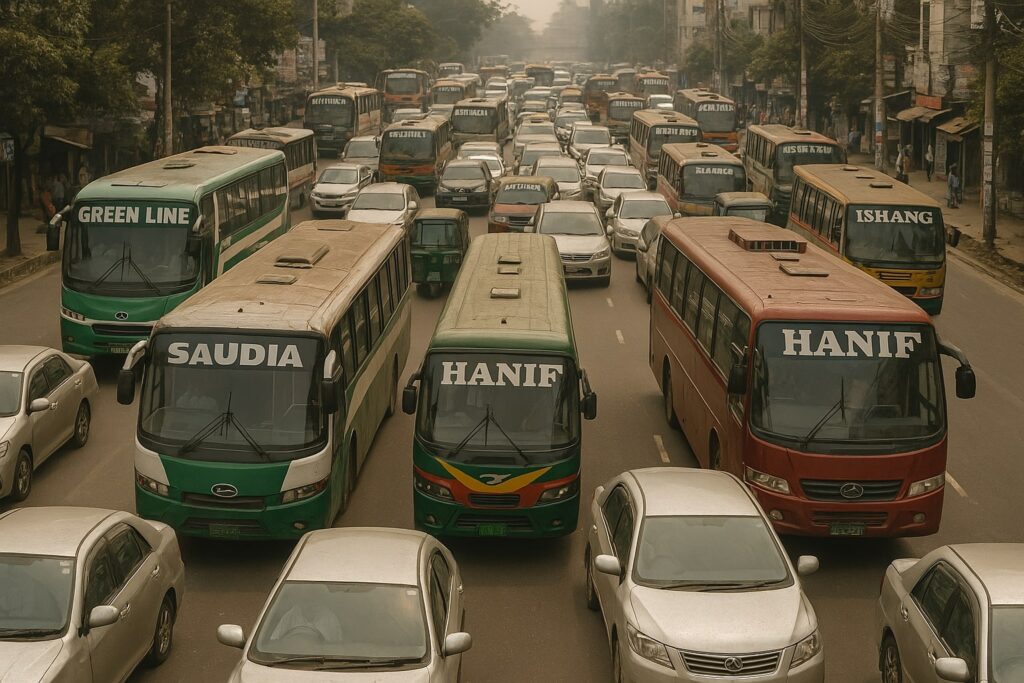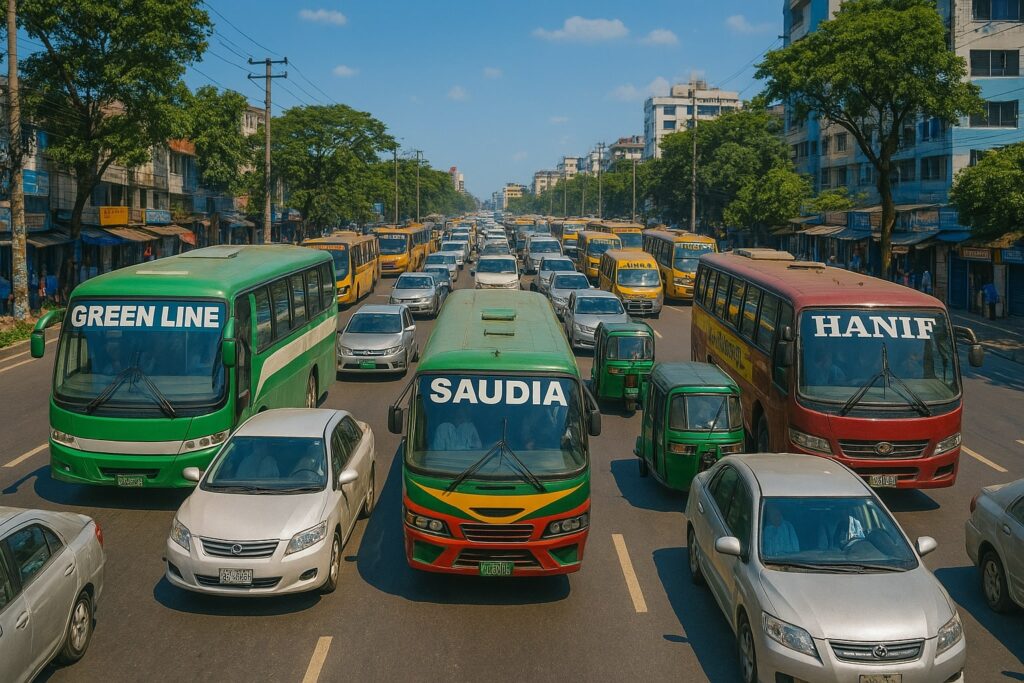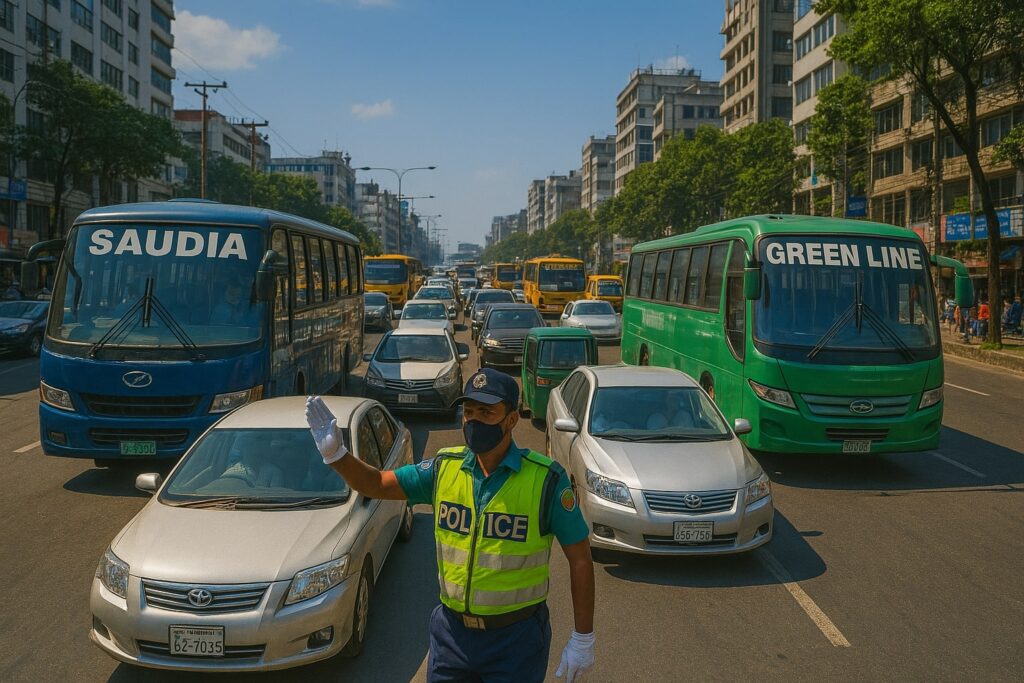Welcome to our specially curated collection of “traffic jam paragraph“. Here, we’ve prepared paragraphs tailored for various academic levels, including Class 6, 7, 8, 9, SSC and HSC. Each paragraph is crafted with a specific word limit appropriate for its respective class, ensuring clarity and ease of understanding.
During this section, you’ll gain a deeper understanding of the causes, effects, and potential solutions to traffic jams. By studying these passages, you’ll enhance your knowledge and prepare for your exams more effectively. We encourage you to select and study the paragraph corresponding to your academic level to strengthen your understanding and improve your writing skills.

Traffic Jam Paragraph for Class 6 (100 words)
Traffic jams happen when too many cars are on the road at the same time. This can cause long delays and make people late for school or work. Sometimes, drivers feel frustrated and angry because they cannot move fast. In a traffic jam, it is important to stay calm and wait patiently. The sound of car horns and engines can be loud and confusing. Many people use buses, bicycles, or walk when the roads are busy. Teachers and parents remind children to be careful while crossing streets during these delays. Traffic jams teach us the value of planning our trips.
Traffic Jam Paragraph for Class 7 (150 words)
A traffic jam is a situation where many vehicles gather on the road, making it difficult to move freely. During rush hours, streets become crowded, and drivers face long waits. The heavy flow of cars can cause accidents, increase pollution, and create stress for everyone on the road. People use different methods to avoid traffic, such as carpooling or taking public transportation. In a traffic jam, it is important for drivers to remain alert, follow road signs, and maintain a safe distance from the vehicle in front. Children learn the importance of road safety by observing traffic patterns. Schools sometimes teach students about the challenges of urban traffic and ways to travel safely. By understanding traffic jams, everyone can work together to find solutions that reduce congestion and protect our environment. These efforts benefit communities and improve daily life for people living in busy urban areas. Everyone must act responsibly.
Traffic Jam Paragraph for Class 8 (180 words)
Traffic jams occur when a large number of vehicles are stuck on the road, often during peak hours or unexpected incidents. This overcrowding makes travel slow and sometimes dangerous, as drivers become impatient and accidents may happen. Many factors contribute to traffic jams, including road construction, poor planning, and high numbers of commuters. Environmental problems also arise, since the cars produce more pollution when they idle for long periods. Experts suggest several solutions, such as improving public transportation, creating carpool lanes, and encouraging alternative travel methods like biking or walking. Students studying traffic management learn that smart urban planning can ease congestion and reduce stress on commuters. Community awareness and responsible driving practices also play an important role in preventing delays. With better infrastructure and modern technology, cities can improve traffic flow and create safer roads for everyone. These combined efforts help create a better future for urban living, where progress and sustainability go hand in hand. Improving traffic conditions not only reduces stress for drivers but also benefits the community by lowering accidents and preserving the environment every day.

Traffic Jam Paragraph for Class 9 (200 words)
Traffic jams are a common problem in modern cities, often resulting from the high volume of vehicles during peak hours. As roads become congested, the flow of traffic slows dramatically, leading to frustration among drivers and commuters. The causes of traffic jams are diverse, including accidents, road maintenance, and poor urban planning. When vehicles stop and start repeatedly, they contribute to increased air pollution and fuel consumption, affecting both the environment and the economy. Many governments are investing in public transportation systems, better road infrastructure, and smart traffic management technologies to alleviate these problems. Students studying these issues learn that efficient traffic flow is vital for urban development and quality of life. They explore topics such as carpooling, public transit, and the use of technology to predict and manage congestion. Moreover, understanding the dynamics of traffic helps citizens appreciate the importance of responsible driving. By following traffic rules and planning their journeys, drivers can help reduce the severity of traffic jams and improve overall road safety. Innovative ideas and cooperative efforts among local authorities, urban planners, and citizens are essential for long-term solutions. These include advanced monitoring systems, improved transit networks, and policies that promote sustainable travel for future progress.
Traffic Jam Paragraph for SSC (250 words)
Traffic jams are a significant issue in many urban areas, affecting daily life for thousands of commuters. They occur when too many vehicles converge on limited road space, especially during rush hours or when accidents disrupt normal flow. This congestion leads to longer travel times, increased fuel consumption, and higher levels of air pollution. As a result, both the environment and public health suffer. Urban planners and government officials are continuously exploring various strategies to manage traffic more effectively. These strategies include the development of efficient public transportation systems, the expansion of road networks, and the integration of smart traffic management technologies. In addition, promoting carpooling and alternative modes of transportation, such as cycling and walking, can significantly reduce the number of vehicles on the road. Educational campaigns also play a crucial role in raising awareness about safe driving practices and the importance of obeying traffic laws. By working together, communities can help reduce congestion, lower pollution levels, and create safer, more livable cities. In the long run, a combination of innovative technology, sustainable practices, and proactive policies is essential for solving traffic jam problems and ensuring a smoother flow of urban life for everyone. Improving traffic conditions requires a collaborative effort from all sectors of society. Researchers study traffic patterns to propose effective solutions, while policymakers design regulations that encourage efficient travel. Community leaders can mobilize public support through local initiatives and educational programs. By embracing both modern technology and traditional planning methods, cities can create a balanced transportation ecosystem. These comprehensive efforts will lead to smoother commutes, reduced stress for drivers, and a healthier environment for everyone, and strongly promote community unity.
Traffic Jam Paragraph for HSC (300 words)
Traffic jams have become a critical challenge in densely populated cities, where the rising number of vehicles strains existing road infrastructures. These congestions not only cause delays and increase travel times but also contribute significantly to environmental degradation and economic losses. In addition to accidents and construction work, poor urban planning and a lack of efficient public transit systems exacerbate the problem. As vehicles crawl along narrow lanes, the continuous idling leads to higher emissions of carbon monoxide and other harmful pollutants. Urban authorities are now considering a wide range of solutions, from expanding road networks to implementing smart traffic management systems that use real-time data to optimize traffic flow. Advanced technologies such as artificial intelligence and automated signal controls are being tested to predict congestion patterns and alleviate bottlenecks. Moreover, public awareness campaigns encourage citizens to adopt sustainable practices like carpooling, cycling, or using public transportation. Educational institutions also play a role by integrating traffic management concepts into their curriculum, helping young minds understand the complexities of urban mobility. Collaborative efforts between government, private sectors, and community organizations are essential to developing innovative strategies that address both current and future challenges. Through a combination of policy reforms, technological advancements, and community engagement, cities can transform their transportation systems to reduce traffic jams and create more livable urban environments. In order to achieve lasting change, it is crucial that all stakeholders participate actively in the process. Researchers must analyze traffic data and provide accurate forecasts while policymakers design regulations that encourage efficient travel. Community leaders can mobilize public support through local initiatives and educational programs. By embracing both modern technology and traditional planning methods, cities can create a balanced transportation ecosystem. These comprehensive efforts will lead to smoother commutes, reduced stress for drivers, and a healthier environment for everyone, indeed.
Traffic Jam Paragraph Bangla
বর্তমান সময়ে আমাদের শহরগুলিতে ট্রাফিক জ্যাম একটি খুব সাধারণ সমস্যা হয়ে দাঁড়িয়েছে। সকাল থেকে সন্ধ্যার বেলা পর্যন্ত অসংখ্য যানবাহন একই সময়ে রাস্তা দখল করে থাকায় যাতায়াত অত্যন্ত ধীর হয়ে পড়ে। এর ফলে স্কুল, কলেজ ও অফিসে সময়মতো পৌঁছানো কঠিন হয়ে ওঠে। কারণ অপরিকল্পিত নগরায়ন, রাস্তার সঙ্কীর্ণতা এবং অপর্যাপ্ত গণপরিবহন ব্যবস্থার মতো বিভিন্ন কারণের মিলিত প্রভাবে এই জ্যামের সৃষ্টি হয়েছে। ট্রাফিক জ্যামে গাড়ি থেমে থাকার কারণে ইঞ্জিনের ধোঁয়া বয়ে চলে এবং পরিবেশ দূষণের পাশাপাশি শ্বাসপ্রশ্বাসের অসুবিধাও সৃষ্টি করে। অনেকেই এই সমস্যার সমাধান হিসেবে পাবলিক ট্রান্সপোর্ট ব্যবহার করার পরামর্শ দেন। সরকার ও নগর উন্নয়ন কর্তৃপক্ষও সমস্যাটি সমাধানের জন্য বিভিন্ন প্রকল্প গ্রহণ করেছে, যেমন নতুন রোড নির্মাণ, আধুনিক ট্রাফিক
নিয়ন্ত্রণ ব্যবস্থা এবং আরও বেশি পরিবহন সংযোগ স্থাপন। এই জ্যাম সমস্যাটি শুধুমাত্র যাতায়াতের ক্ষেত্রে বিলম্ব সৃষ্টি করে না, বরং আমাদের দৈনন্দিন জীবনের ওপরও নেতিবাচক প্রভাব ফেলে। এ কারণে মানুষ চাপ ও উদ্বেগে ভোগ করে। স্কুলের শিক্ষার্থীদেরও ট্রাফিক জ্যামের সময় নিরাপত্তা ও সচেতনতার শিক্ষা দেওয়া হয় যাতে তারা সড়কে সাবধান থাকতে পারে। একইসাথে, পরিবেশ সংরক্ষণের জন্য গাড়ির বিকল্প হিসেবে সাইকেল বা হাঁটার পরামর্শ দেওয়া হয়। ভবিষ্যতে, উন্নত প্রযুক্তির সহায়তায় স্মার্ট ট্রাফিক নিয়ন্ত্রণ ব্যবস্থা চালু হলে আশা করা যায় যে, এই জ্যাম সমস্যা কিছুটা হলেও কমে আসবে। সবাই মিলে যদি পরিকল্পিতভাবে চলাফেরা করি, তাহলে আমাদের শহরগুলি আরও সুন্দর ও নিরাপদ হয়ে উঠবে। ট্রাফিক জ্যাম দূর করার জন্য আমাদের সঠিক পরিকল্পনা ও সহযোগিতা প্রয়োজন। স্থানীয় প্রশাসন আধুনিক প্রযুক্তি ব্যবহার করে চলাচলের মান উন্নত করতে পারে। ব্যক্তিগত ও সামাজিক দায়িত্ব পালন করলে পরিবেশ রক্ষা ও স্বাস্থ্য সুরক্ষায় সহায়ক হবে। প্রতিদিনের যাত্রাপথে নিয়মিত ও সঠিক আচরণ রাস্তাঘাটে শান্তি বজায় রাখে। এই সমস্যা থেকে মুক্তি পেতে সকলের একতাবদ্ধ প্রচেষ্টা অপরিহার্য। আমরা যদি সচেতন থাকি, তবে ট্রাফিক জ্যাম কমে আমাদের জীবন হবে সহজ, নিরাপদ ও সুন্দর। আধুনিক প্রযুক্তির সাহায্যে ট্রাফিক ব্যবস্থাপনা উন্নত করা সম্ভব, যা শহরের ব্যস্ততা কমিয়ে সবার জন্য সহজ ও সুবিধাজনক যাতায়াত নিশ্চিত করে। এটি আমাদের ভবিষ্যতের জন্য অত্যন্ত গুরুত্বপূর্ণ।

Traffic Jam Paragraph – Q&A Section
Q1: What is a traffic jam?
A: A traffic jam is a situation where vehicles are unable to move freely due to overcrowding on the roads.
Q2: What are the main causes of traffic jams?
A: The main causes of traffic jams include too many vehicles, narrow roads, poor traffic management, and illegal parking.
Q3: How does traffic jam affect our daily life?
A: Traffic jams waste valuable time, increase mental stress, cause air pollution, and sometimes lead to accidents.
Q4: Which areas usually face traffic jams?
A: Busy city roads, intersections, and school or office areas during rush hours often face traffic jams.
Q5: How can we reduce traffic jams?
A: We can reduce traffic jams by following traffic rules, using public transport, improving road conditions, and spreading traffic awareness.
Q6: Why is traffic jam considered a serious problem?
A: Because it disrupts daily activities, harms the environment, wastes fuel, and affects the economy.
Q7: What role can students play to reduce traffic jams?
A: Students can raise awareness about traffic rules, encourage walking or cycling, and promote carpooling.
Q8: How does traffic jam harm the environment?
A: It increases air pollution and noise pollution due to long periods of idling vehicles.
Q9: What is the best solution to traffic jam in big cities?
A: Introducing better public transport, smart traffic signals, and strict law enforcement can help reduce traffic jams.
Q10: Can traffic jam be solved completely?
A: It may not be fully solved, but it can be greatly reduced with proper planning, awareness, and public cooperation.
Thanks for reading …
Author
Asif Khan
SEO specialist